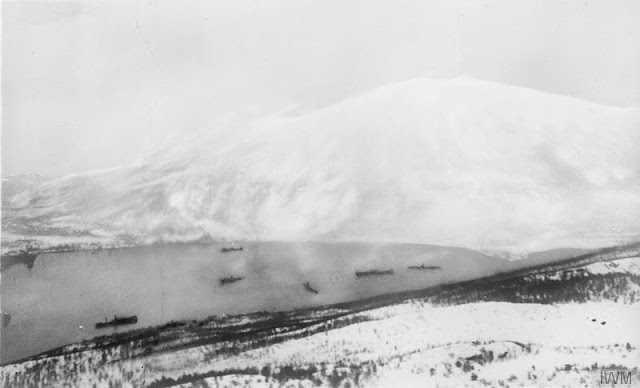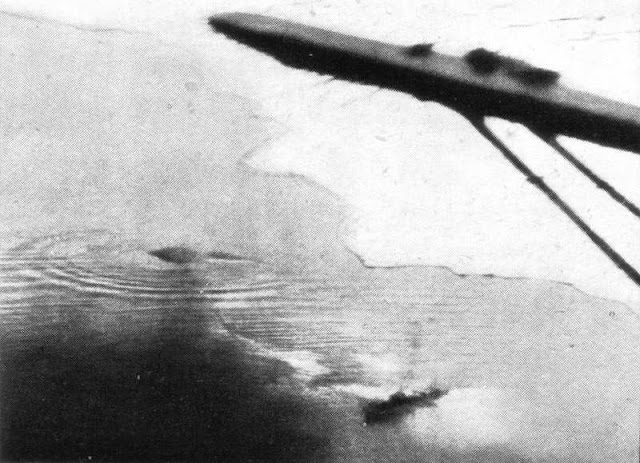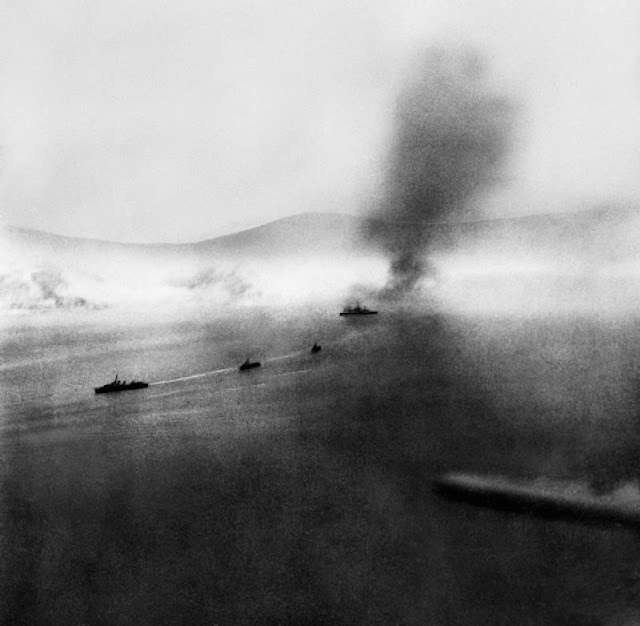Saturday 13 April 1940
 |
| Ships at Narvik at some point during the second battle of Narvik. The photo was taken by the spotter plane from HMS Warspite. |
- German troops continue expanding away from their beachheads in the major Norwegian cities:
- German 163rd Infantry Division occupies Larvik near Oslo;
- German 196th Infantry Division occupies Halden and pushes northward;
- Junkers Ju 52s fly supplies to Lake Hartvigvann near Narvik, landing on the frozen lake.
the grave danger that we should find ourselves committed to a number of ineffectual operations along the Norwegian coast, none of which would succeed.Prime Minister Chamberlain, his authority reeling from the Norwegian setback and his own recent comment that Hitler has "missed the bus," vows to send troops to Norway anyway. He tells the House of Commons, "Hitler has a real fight on his hands!"
One of Hitler's orders does go through. Generaloberst Nikolaus von Falkenhorst, commanding the Weserubung operation, receives orders to seize control of the village of Dombås, some 336 km (209 mi) north of Oslo, by paratroop attack. This is due to a false report of Allied landings at Åndalsnes. It also may have something to do with the transport of Norwegian gold reserves out of the country and an attempt to seize the gold.
 |
| Battle of Narvik on 13 April 1940. |
- Z2 Georg Thiele (sunk)
- Z9 Wolfgang Zenker (scuttled)
- Z11 Bernd von Arnim (scuttled)
- Z12 Erich Giese (scuttled)
- Z13 Erich Koellner (sunk)
- Z17 Diether von Roeder (sunk)
- Z18 Hans Lüdemann (scuttled)
- Z19 Hermann Künne (scuttled)
 |
| The aftermath of the Battle of Narvik on 13 April 1940. |
However - and this is a qualification - despite the absolute devastation wreaked by the Warspite force, the Wehrmacht under General Dietl retains control of the town of Narvik itself, and 2,600 Kriegsmarine personnel from the destroyers augment the ground troops. Whitworth signals London and tells them that a single brigade could take the key port.
Elsewhere, U-34 (Kapitänleutnant Wilhelm Rollmann) destroys Norwegian Cruiser-minelayer HNoMS Frøya, which has been beached at Søtvika, Norway after encounters with other Kriegsmarine ships.
Convoy OB 128 departs from Liverpool, and Convoy HG 26 departs from Gibraltar.
European Air Operations: The RAF sends 15 Hampden bombers to drop parachute mines off the Danish coast during the night. While the Luftwaffe has dropped mines regularly, this is the first time the RAF drops mines. One aircraft is lost.
Luftwaffe bombers make unproductive attacks against Royal Navy vessels along the Norwegian coast.
Following the successful long-range reconnaissance of Narvik from northern Scotland performed by the New Zealand (75 NZ) Squadron on 12 April, another flight is taken over Trondheim. This time, the plane fails to return.
German Military: Morale within the Wehrmacht is skyrocketing given the latest successes in Norway. While difficult to quantify, it manifests itself in interactions with the British, who are not feeling quite so sanguine. For instance, the British rescue some of the German sailors at Narvik and make them prisoners but are nonplussed at their attitude. One of the Royal Navy sailors guarding them, Harry Neesdowne on battleship HMS Warspite, notes of them: "They are impossibly arrogant- certain of victory" - and this right after they have been pulled from the water and locked up.
 |
| Battle of Narvik on 13 April 1940. |
Legendary General Carton de Wiart takes command of troops in Norway.
Spies: US embassy official Tyler Kent passes copies of documents to Anna Wolkoff, who gives them to the German embassy.
US Navy: Destroyer USS J. Fred Talbot returns to the Canal Zone after its humanitarian mission to aid an ill passenger on the Japanese steamship Arimasan Maru.
Poland: The German authorities in occupied Poland permits the formation and meeting of the Ukrainian Central Committee. It is allowed to represent the concerns of Ukrainian citizens. Numerous local groups operate under its umbrella.
Holocaust: Approximately 250,000 additional Poles in the Soviet-occupied zone of former Poland are banished to Siberia.
American Homefront/Future History: The New York Rangers beat the Toronto Maple Leafs 3-2 in overtime to win the 1940 Stanley Cup. It is the last time the Rangers win the Cup for 54 years. As the years lengthen during that span, the derisive chant "1940! 1940!" becomes a rallying cry for fans of the team's opponents. It is one of the most enduring legacies of 1940 for hockey fans.
 |
| The Warspite (left) force withdrawing during the Battle of Narvik on 13 April 1940. |
April 1940
April 1, 1940: Weserubung is a GoApril 2, 1940: British Subs On Alert
April 3, 1940: Churchill Consolidates Power
April 4, 1940: Missed the Bus
April 5, 1940: Mig-1 First Flight
April 6, 1940: Troops Sailing to Norway
April 7, 1940: Fleets At Sea
April 8, 1940: HMS Glowworm and Admiral Hipper
April 9, 1940: Invasion of Norway
April 10, 1940: First Battle of Narvik
April 11, 1940: Britain Takes the Faroes
April 12, 1940: Germans Consolidate in Norway
April 13, 1940: 2d Battle of Narvik
April 14, 1940: Battle of Dombås
April 15, 1940: British in Norway
April 16, 1940: Germans Cut Norway in Half
April 17, 1940: Trondheim the Target
April 18, 1940: Norway Declares War
April 19, 1940: Dombås Battle Ends
April 20, 1940: Germans Advancing in Norway
April 21, 1940: First US Military Casualty
April 22, 1940: First British Military Contact with Germans
April 23, 1940: British Retreating in Norway
April 24, 1940: British Bombard Narvik
April 25, 1940: Norwegian Air Battles
April 26, 1940: Norwegian Gold
April 27, 1940: Allies to Evacuate Norway
April 28, 1940: Prepared Piano
April 29, 1940: British at Bodo
April 30, 1940: Clacton-on-Sea Heinkel
2019
No comments:
Post a Comment